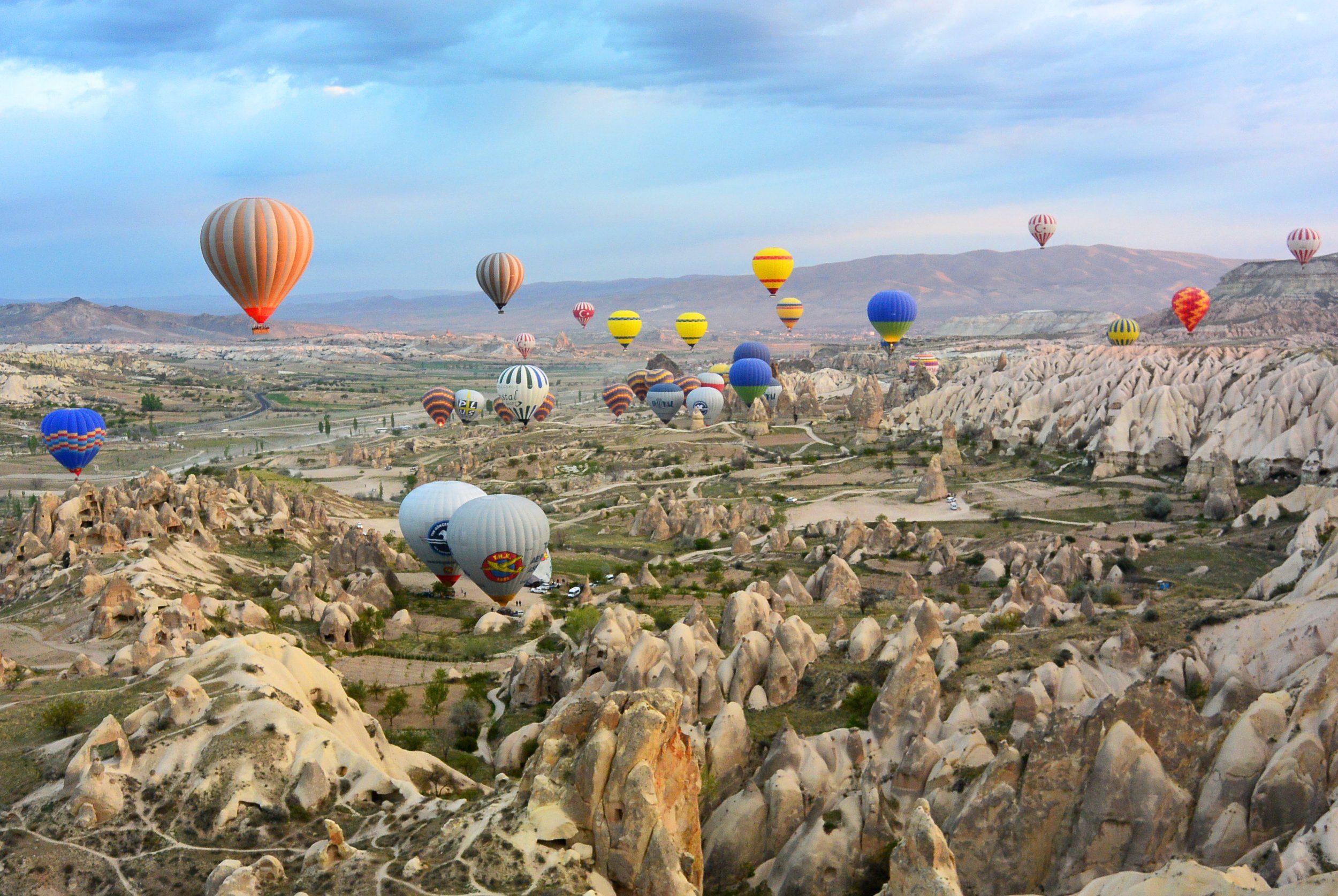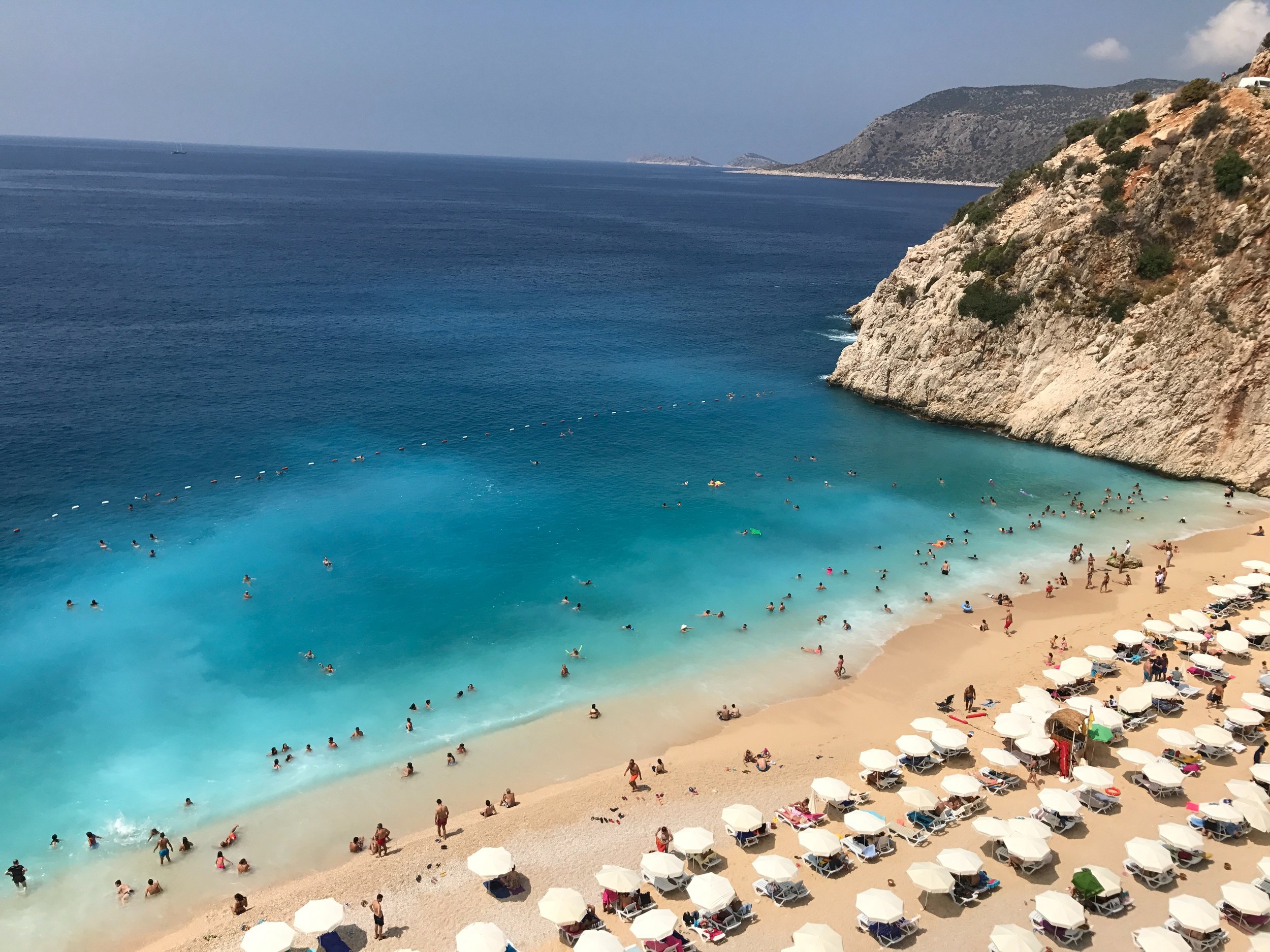If you love multicultural history, you will love Turkey. Home to 80 million inhabitants, Turkey is what I would call a dynamic country, with an array of historical places and archaeological excavation sites. The country is full of contrasts, and best known for its Ottoman mosques and palaces, its fairy tale-like Cappadocia to Classical cities like Ephesus in the Turkish Aegean. Here is my list of iconic places to visit while in Turkey:
1. Goreme Open Air Museum, Cappadocia – I visited Cappadocia from Istanbul after a short visit to Ephesus and Pammukale. I immediately noticed Cappadocia’s landscape was different from anything else I have ever seen during my travels. The best word to describe this unique city would be “moonscape” like. I stayed in Goreme, a town in Cappadocia, located among the “fairy chimney” rock formations that the region is well known for. The volcanic landscape is entirely sculpted by erosion to form mountain ridges, valleys and pinnacles known as “fairy chimneys” or hoodoos. Goreme National Park and the Rock Sites of Cappadocia cover the region between the cities of Nevsehir, Urgup, Avanos, and the subterranean cities of Kaymakli and Derinkuyu. The Goreme Open Air Museum is a testament to Byzantine life and one of Turkey’s UNESCO World Heritage site. It used to house some 20 monks and was an important Byzantine monastic settlement with its rock-cut churches, chapels and monasteries. You can also see beautifully painted murals dating from 900-1200 AD inside these churches. This open-air museum is a must on a visit to Cappadocia.
2. Kaymakli, Cappadocia – Kaymakli is an underground city that dates back to the Hittites and is the largest one in Cappadocia. There are 36 underground cities beneath the rock formations of Cappadocia. They use to house up to 10,000 people each and were first used by the people of Cappadocia to escape the winters and the wild animals. Later they became a refuge for the Christians who escaped persecution from the Roman soldiers. Kaymakli is one of the underground cities that’s believed to be the widest, and consists of eight floors below, although only four are open to the public. There is a winery, ventilation shafts, storage rooms, bedrooms, stables and even a church – it’s unbelievable to see how they have built this city with just hand tools, minus electricity. Be prepared to bend and crouch through the different tunnels that connect each room.
3. Hot Air Balloon, Cappadocia – A hot air balloon ride in Cappadocia is the ultimate way to experience this beautiful, unique landscape. Imagine being able to glide through the valley and witness the dramatic lunar like landscape, rock formations, peeking into caves and well also floating past other hot air balloons. At the end you will be rewarded with a champagne toast.
4. Ephesus – Ephesus was the site of a vast city dating back over 2,000 years and today its ruins provide a glimpse into history and some wonderful architecture. It is now one of the biggest Roman archaeological sites of the eastern Mediterranean. The Aegean Sea used to be up right against the city but due to deforestation and erosion, the waters have now receded. Just a half hour drive away is the beach town of Kusadasi that boasts a sparkling azure beach. Ephesus is best known for the Temple of Artemis, one of the Seven Wonders of the Ancient World. The temple was rebuilt three times before it was completely demolished in 401 CE. While almost nothing remains of this temple anymore, you can walk ahead to see the breathtaking facade of the Library of Celsus. Climb up the steep steps of the Great Theater and imagine watching a performance here. This theater alone could hold 25,000 spectators and might well be the largest outdoor theater in the ancient world. You can stroll through majestic ancient columns, and walk through the Gate of Augustus that might make your heart skip a beat with all its grandeur.
5. Pamukkale – Pamukkale is home to the brilliant, white travertine terraces filled with water that cling to a steep valley in Turkey’s southwest. This is a geological phenomenon and in Turkish translates to “Cotton Castle” and also the site of the well-preserved ruins of the Greek-Roman city of Hierapolis. Pammukale is classified as a UNESCO World Heritage site and with over two million visitors annually, it might very well be Turkey’s single most visited attraction. You can walk through the terraces and even dip in the water but try to avoid going during the day due to the extreme heat and crowds. This is one of my favorite memories of Turkey overall.
6. Anatalya – Antalya is the gateway to the Turquoise seas where a trip to the Greco-Roman ruins at Side is a must. The vast theater here is known to seat more than 15,000 people and the Temple of Apollo nearby is best during sunset. Kleopatra Beach is one of the finest spots to be on the coast and the mile-long sandy beach is perfect for water sports or to stroll between beach bars to savor a sun downer or two. Venturing inland brings you to the Taurus Mountains where from Alanya you can head up into remote villages along the Dim river. Alanya is the harbor district and is great for authentic Turkish folk music or if you want to hit the dance floor in the colorful clubs. If you walk through the 1,880 year old Hadrian’s Gate to Kaleici, this is the old quarter of Antalya where shopping is plenty and cheaper than the markets. The Tahtali cable car whisks you up to 7,750ft in just 15 minutes and you can experience a beautiful sun rise here.
7. Istanbul – Istanbul is not the capital of Turkey but it is a major city that straddles Europe and Asia across the Bosphorus Strait. The old town is a pleasure to stroll through where you can see the influences of the many empires that once ruled here. I have so many favorite monuments here that I enjoyed visiting, one of them being the iconic Byzantine Hagia Sophia which features a soaring sixth century dome and some rare Christian mosaics. Built between 532 and 537, this was a church for nearly thousand years and then served as a mosque from 1453-1935 before becoming the secular museum that it is today. The Blue Mosque is another sight to behold with its array of domes, semidomes, and minarets. I also loved the Suleymaniye Mosque which is considered one of the city’s most impressive Ottoman mosques. This structure features multiple gardens, a large dome and mother-of-pearl window shutters, painted corbels, traditional ceramic tiles and stained-glass windows. The Grand Bazaar is so much fun to walk through and is one of Istanbul’s biggest and oldest covered shopping markets in the world. It has 60 streets and 5,000 plus shops and you can buy anything ranging from carpets to clothing to art and it even has restaurants, cafes and hammams. For the best views of Istanbul from Beyoglu, head up the Galata Tower. This tower crowns the hill opposite the Golden Horn and was once used as a jail. The Basilica Cistern is Istanbul’s largest surviving Byzantine cistern and is a sprawling underground water reservoir. It once supplied water to the Great Palace of Constantinople. The Topkapi Palace is another favorite of mine and served as the home of the Ottoman Sultans. It officially became a museum in 1924 and is known for its stunning architecture, courtyards and extensive weaponry, porcelain, cutlery and fabric collection.
Written by Preethi Chandrasekhar, follow her adventures on Instagram.







